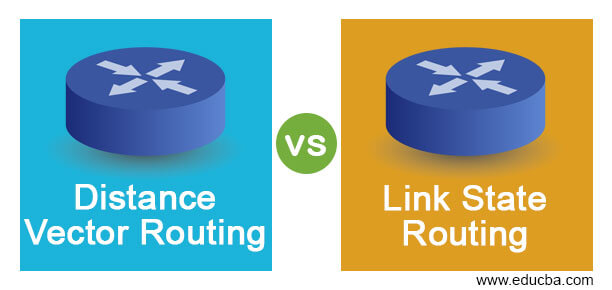Updated March 29, 2023

Difference Between Distance Vector Routing vs Link State Routing
The following article provides an outline for Distance Vector Routing vs Link State Routing. A router does not need to know the complete route to each network segment in distance vector routing; it just needs to understand the vector or direction in which to deliver the packet. This method calculates the distance, i.e. hop count and direction, i.e. vector to any network in an internetwork. On a regular basis, distance vector routing approaches broadcast parts of the routing table during their next neighbors. Therefore, even if there are no changes in the network, routers using the distance vector routing protocol will provide frequent updates. Based on updated information received from neighbouring routers, a router verifies all known routes as well as make modifications to its local routing table. Because the routing knowledge a router possesses of the network topology is dependent on the perspective of the routing table of the neighbour router, this approach is known as “routing by gossip.”A typical distance vector protocol which uses routing metrics or hops counts are RIP and IGRP.
In link-state routing, every router attempts to create its internal map of network infrastructure. When the router first becomes operational, it transmits messages to the network and gathers data from routers with whom it is connected directly. It tells you whether or not the link to the router is active. Other routers utilise this information to create a network topology map. The router then scans the map to select the best route. The link-state routing methods respond quickly to changes in the network. It delivers triggered updates if there is a change in the network and periodic updates every 30 minutes. If the state of the link changes, the device that detected the change generates and sends an update message to all routers. The message is then forwarded to all neighbouring routers once each router receives a copy of the update message as well as updates its routing database. The update message must be flooded to guarantee that all routers update their databases before generating an update routing table that incorporates the new technology. The OSPF protocol is an example of link state routing.
Head to Head Comparison Between Distance Vector Routing vs Link State Routing (Infographics)
Below are the top 11 differences between Distance Vector Routing vs Link State Routing:
Key Difference Between Distance Vector Routing vs Link State Routing
Let us discuss some of the major key differences between Distance Vector Routing vs Link State Routing:
- The Bellman-Ford algorithm is utilised for distance vector routing; on the other hand, the Dijsktra algorithm is used in link state routing.
- The routers receive the topological information in distance vector routing. In contrast, in link state routing, a router receives comprehensive network topology information.
- Distance vector routing determines the best path based on the distance between two points. Link state routing, on the other hand, determines the best route based on the lowest cost.
- Both routing techniques have distinct update frequencies, with distance vector changes occurring on a regular basis in one and triggered updates in the other.
- When compared to link state routing, distance vector routing uses less CPU and memory.
- The bandwidth of Distance vector routing is less, whereas wide bandwidth is available in Link state routing.
- Distance vector routing is easy to set up and maintain. On the other hand, the link state routing is complicated and necessitates the use of a qualified network administrator.
- Distance vector routing has a delayed convergence time and frequently suffers from the count to infinity problem. Link state routing, on the other hand, has a faster and more consistent convergence time.
- Although the distance vector does not have one, the nodes in link state routing can have a hierarchical structure.
Distance Vector Routing vs Link State Routing Comparison Table
Let’s discuss the top comparison between Distance Vector Routing vs Link State Routing:
| Sr. No | Distance Vector Routing | Link State Routing |
| 1 | The Bellman-Ford algorithm is utilised for distance vector routing. | The Dijsktra algorithm is used for link state routing. |
| 2 | Information on topology from the view of a neighbour. | Complete information on the network topology. |
| 3 | The best path calculation in Distance Vector Routing is based on the least number of hops. | The best path calculation in Link State Routing is based on the cost. |
| 4 | It updates the full routing table. | It updates Link state updates. |
| 5 | It has Periodic updates. | It has Triggered updates. |
| 6 | CPU and memory in this is of Low utilisation. | CPU and memory in this is Intensive. |
| 7 | There is no need of professional expertise to use it. | It needs a qualified network administrator. |
| 8 | Convergence time in this is Moderate. | Convergence time in this is fast. |
| 9 | It does not has a Hierarchical structure. | It has a Hierarchical structure. |
| 10 | There are no Intermediate Nodes. | There are Intermediate Nodes. |
| 11 | The bandwidth of Distance vector routing is less. | In Link state routing, wide bandwidth is available. |
Conclusion
The information of the completely autonomous system and the data is shared only with neighbours in distance vector routing. In link state routing, on the other hand, routers communicate just information about their neighbours; the information is shared among all routers. Here we have seen key differences between Distance Vector Routing and Link State Routing.
Recommended Articles
This is a guide to Distance Vector Routing vs Link State Routing. Here we discuss key differences with infographics and comparison tables respectively. You may also have a look at the following articles to learn more –

